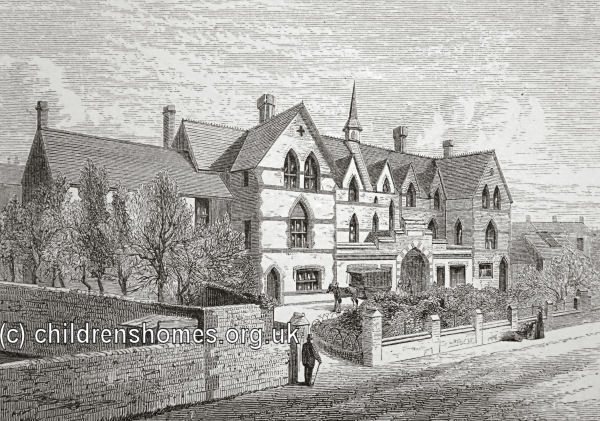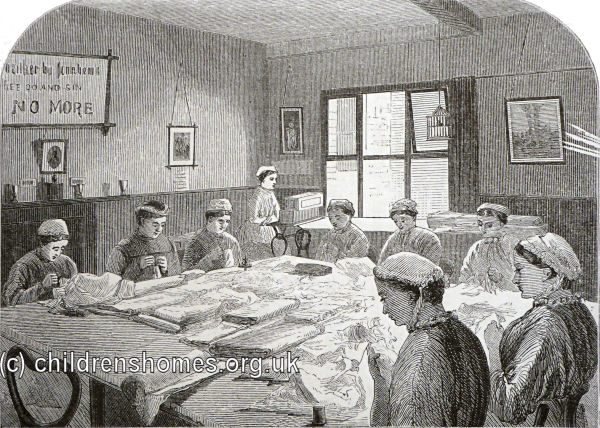Home for Female Penitents, Brighton, Sussex
The Home for Female Penitents, a Magdalen Home, was founded in 1853 by a local clergyman, George Wagner, in collaboration with Mrs Murray Vicars. It initially occupied premises opposite the Level, soon moving to larger premises in Lewes Road. It moved again in 1855 to Queens Square where its facilities were expanded to include a lying-in hospital, nursery, industrial school and dispensary.
A new building was opened in 1868 on Finsbury Road, in the Albion Hill district of Brighton. The Home was subsequently managed by a local branch of the Ladies' Association for the Care of Friendless Girls. In 1884, the premises could accommodate up to 70 girls, aged from 14 to 24 at their date of admission. The home took Brighton cases without payment, if they were destitute and 'friendless'; others were required to pay 5s. a week. Those admitted were requited to remain for 'such period as may be thought advisable'.

Albion Hill Home, Brighton, 1870s. © Peter Higginbotham

Albion Hill Home wash house, Brighton, 1870s. © Peter Higginbotham

Albion Hill Home ironing room, Brighton, 1870s. © Peter Higginbotham

Albion Hill Home work room, Brighton, 1870s. © Peter Higginbotham
The weekly dietary at the home is shown below.
| BREAKFAST | |
|---|---|
| Every Day | Half-pint of tea and bread and butter. |
| DINNER | |
| Monday | Meat soup, suet puddings and potatoes. Rice and treacle. |
| Tuesday | Meat puddings. Rice and potatoes. |
| Wednesday | Meat and sliced potatoes — baked. Suet puddings. |
| Thursday | Bacon and hard pudding. Vegetables. |
| Friday | Baked meat and batter pudding. Vegetables. |
| Saturday | Bread and cheese. |
| Sunday | Boiled beef. Potatoes. Plum pudding. |
| TEA | |
| Every Day | Half-pint of tea and bread and butter. |
| SUPPER | |
| Every Day | Bread and cheese. |
In 1917, management of the institution was taken over by the Church Army. On July 17th of that year, part of the site referred to as London Cottage was certified for use as a Reformatory, with accommodation for up to ten girls. The following October, a joint certificate was issued for London Cottage and for the Church Army's Queen Elizabeth Lodge Reformatory at Old Southgate, London. In December 1919, 'London Cottage' was replaced by St Elizabeth's House at 18 West Drive, Brighton. It was granted a replacement Reformatory certificate, with part of the Finsbury Road premises, referred to as Murray Vicars' House, designated as a branch establishment. Murray Vicars' House was removed from the certificate in October, 1920.
The Finsbury Road premises were then divided into three sections, each accommodating twenty young women aged from 16 to 25 years:
- Bevan House — for 'fallen girls without children', who paid 5s. per week, if possible.
- Albion House — for young unmarried mothers before and after confinement, who were charged 10s. per week.
- Murray Vicars' House — Girls requiring treatment for V.D. who also paid 10s. per week.
On 17 July 1917, Murray Vicars' House, also known as the Church Army Special School for Girls, The certificate was rescinded on 11 November 1920.
By 1930, Murray Vicars' House were being used for young unmarried mothers, aged 14 to 16, with their babies. In 1935, Bevan House had taken on the same role.
In the 1950s, the Finsbury Road building was converted for use as a furniture factory.
Records
Note: many repositories impose a closure period of up to 100 years for records identifying individuals. Before travelling a long distance, always check that the records you want to consult will be available.
- East Sussex Record Office, The Keep, Woollards Way, Brighton, BN1 9BP. Has: Letters and papers concerning the Brighton Home for Female Penitents (1858-63); Work Among the Lost by Jane Ellice Hopkins — a series of three printed articles describing the foundation of the home, from The People's Magazine (July-September, 1869).
Bibliography
- Hopkiins, Ellice Work in Brighton, or, Woman's Mission to Women (1878)
- Bartley, Paula Prostitution: Prevention and Reform in England, 1860-1914 (2000, Routledge)
- Finnegan, Frances Poverty and Prostitution: A Study of Victorian Prostitutes in York (1979, CUP)
- Hopkins, Jane Ellice, Work Among the Lost (1870, William Macintosh) Nokes, Harriet Twenty-Three Years in a House of Mercy (1886, Rivingtons)
- Taylor, William J The Story of the Homes (1907, London Female Preventive and Reformatory Institution)
- Thomas, E W Twenty-Five Years' Labour Among the Friendless and Fallen (1897, Shaw)
Links
- None identified at present.
Except where indicated, this page () © Peter Higginbotham. Contents may not be reproduced without permission.


